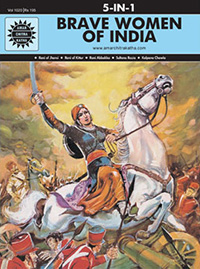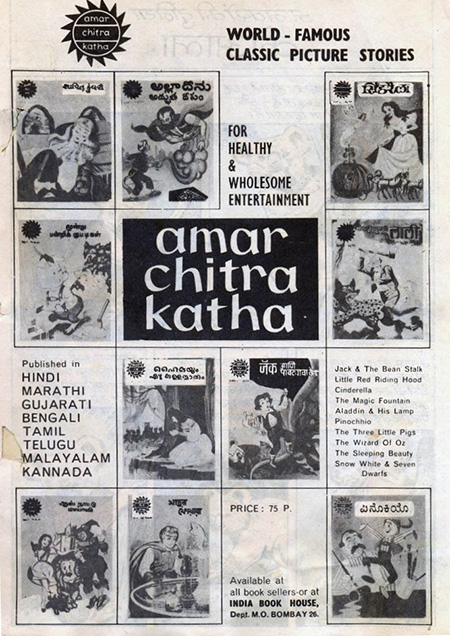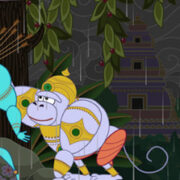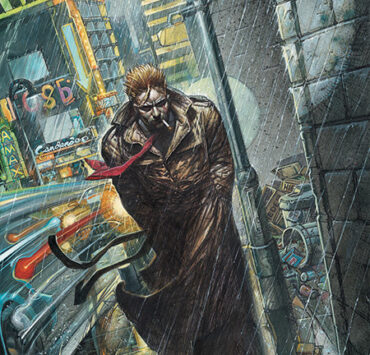When I was in school, I had this rather fearsome teacher who always looked like she had a hatchet hidden away in her obscenely large bag. It wasn’t so much the bag or its size that bothered me, but the loving way in which she cradled it. It was about the only thing she did lovingly (at least around me and my fellow classmates). I am convinced that she enjoyed reading out incredibly dull passages from our social science textbook. By the time our country’s history and culture came to us via her raspy and cold voice, all the different colours of diversity had been duly dried out.

The comic books, translated into almost every Indian language, paint misleading pictures of communal harmony and peace, while perpetrating stereotypes of gender, caste, and creed.
So, like many others before me, I turned towards Amar Chitra Katha. And it was through the carefully organised pages of these comic books that I learnt about the Mahabharata, about the struggle for India’s independence, so on, and so forth.
What if I told you that Amar Chitra Katha comics are racist and biased; that they portray a false image of India?
As the story goes, Anant Pai, the creator of the comic book series, was disgusted to find that the Indian youth knew more about Greek and Roman mythology than they did about their own culture and history. This idea slowly germinated into Amar Chitra Katha, a series of illustrated books and comics that has been translated into 20 Indian languages and has sold more than 90 million copies.
Anant Pai became ‘Uncle Pai’ and Amar Chitra Katha codified and replaced the oral tradition of grandmothers telling stories while bedazzled grandchildren struggled against leady eyelids. Amar Chitra Katha came about around the same time that the great Indian nuclear family raised its individualistic head. There is no doubt about the fact that the comic books play an important role in preserving our cultural heritage. But the question remains: At what cost?

The comic book title Maharishi Dayananda carefully ignores the ways in which the Arya Samaj laid the foundation for Hindu nationalism in India, and the consequent communal violence.

The brave women of India that the comics portray all got married and cooked hot, tasty meals for their husbands. Being brave is fine and good, but being a woman (and not a man) is a full-time job, says Uncle Pai.
Take for instance the comic books dealing with Dayananda Saraswati, founder of the Arya Samaj. The introduction to the books reads thus—“He did not, however, propagate or establish a new creed or a new sect like many of his contemporaries… his main purpose behind establishing the Arya Samaj was to make people good, to rid the society of its evils, and thereby build a free, strong and united nation”.
The Arya Samaj encapsulates the beginnings of Hindu nationalism and how dear old Uncle Pai came to this equation between Hindu superiority and a strong nation is something I am not very clear about. Another instance would be the colour spectrum into which characters are dipped into before being placed into the carefully edited stories of Amar Chitra Katha. Hindu gods are (obviously) blue, ‘normal’ people are a homogeneous shade of brownish pink and lower castes/untouchables are a darker shade of brown. These immortal pictorial stories seem to suggest that higher castes are somehow a shade fairer than the lower untouchables. Now, such vivid differences might come in handy when a lower caste character is hugged by the benign, albeit fairer, higher caste character in the bubble gum world of the comic book, but when one takes into account that being “Fair and Lovely” in our country is about as important as being educated, things get slightly more complicated.
India has the largest market for fairness products, and I am not simply trying to suggest a correlation between Amar Chitra Katha and Fair and Lovely (or Fair and Handsome, for that matter). Instead, I am trying to point out that there exists an entire mine field of historical misinterpretations, inadequate research, and harmful stereotypes.
Amar Chitra Katha forms the very foundation of the canon of Indian fables, myths, history, and culture. Children in our country devour them in the way that I imagine hungry pigs would devour a piece of toast. The comic books are inaccurate and a very effective piece of propaganda—I would even go so far as to say that they are one of the spinal blocks of our national identity.
Don’t you find that to be even a tiny bit scary?









Aniruddh – fantastic article. This perspective is part of what inspired me to create http://www.ackcomic.com
The effect you are describing was even more pronounced for an American-born Indian like myself. With fewer cultural artifacts linking us to India, we (and our parents) turned Amar Chitra Katha into a definitive piece of our religion and identities.
Now, my views possibly go a bit further, and the intent of my comic is to poke fun and point out absurdity not only at Amar Chitra Katha, but the Mahabharata in general. But since ACK was the only translation I had throughout my childhood, I’m not sure I can distinguish between the two anymore.
Thanks again,
Sandeep
Interesting. True. Scary, deeply. Most people read these at a rather young age…I did too, and never thought much about how it propagates racism, not to mention sexism. Maybe it’s high time for a revamp.
Brilliantly written piece!
I used to love Amar Chitra Katha comics as a kid, and frankly, these distinctions did not enter my mind when I read them. And last I checked, I am not a violent Hindu fundamentalist who believed in the caste system and judged people based on their colour. Sometimes, I wish people would just let these things be, instead of casting their idle minds, on topics, most notably from their past, to dissect and destroy, really. Like Byatt wrote, “Everything relates to *us*, and so we’re so imprisoned in ourselves – we can’t see *things*. And we paint everything with this metaphor.”
I completely agree with Ladyhawke.
Gender bias/communal violence/colour distinctions.. I think it’s silly to pick on amar chitra katha for these… Maybe there are other things to blame, hmm? I don’t think I even thought about these things while reading them as a kid; I was merely fascinating by the stories.
Also, I thought Lord Krishna is shown in blue to imply that he is dark-skinned.
You cannot treat ACK as the sole source of intelligence and perception for a young child. And the overt political correctness that your article, though beautifully written on a touching subject, expounds has caused much silliness and over-reaction across the world already.
I agree, ACK isn’t the sole source of intelligence. And don’t get me wrong, I am not saying that ACK is evil incarnate. All, I am saying is that the assumption that certain things are true, or even unbiased can be harmful. Not for everyone, but for some. And more importantly, the right-wing nationalism/sexism or whatever politics that ACK has – isn’t necessary a unitary project. On its own it probably can’t turn you into a gun-popping-Hindu-saffron-clad-militant.
If we take Nationalism as an example, we have ACK comic books like Dayanand; films like Border and Gadar and a host of other media.
As far as just letting somethings be, its those things that are the most suspect. Children’s literature, as lovely as they might be, are the most insidious. I guess, that does seem a bit cynical.
Our knowlegde about even if not all, many personalities or epics are limited to what we read as children in comics and school textbooks. It can be quite misleading if we do not revisit these topics again which are either too simplistic or very subtly sanitised off the real issues and prejudices.
Arya Samaj…was a Hindu reform movement which condemned traditional “hindu” practices like child marriage, untouchability, and so forth…if there was ever any good in a religion like Hinduism, or any other, I think the purpose was to bring out that good (hence, a “reform” movement)…and not so much about Hindu superiority.
Did they achieve their purpose? I don’t know, and I think it stopped being relevant long ago.
…as for the implications of the seemingly subtle racist projections of Amar Chitra Katha — the stories never planted any seeds of discrimination or fair and lovely gibberish in my head — in fact, ACK was slightly more bearable than the barbies and the “rosy cheeks eyes are blue” tosh most of us ingested while growing up.